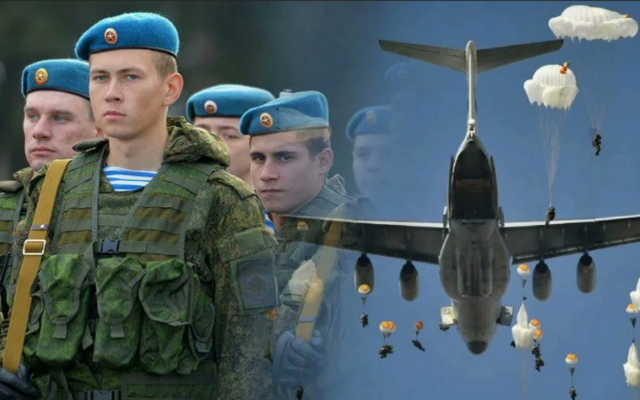The airborne troops of Russia cause pride among our citizens and envy among our "partners". The proposed article was published in early February 2022, before the start of a special military operation in Ukraine. At the same time, it is written under the impression of the actions of the CSTO peacekeeping forces in Kazakhstan and accurately conveys the state and capabilities of the Russian Airborne Forces.
Author: Dr. Christian Herrmann (Christian Herrmann) is a teacher of security issues at the Federal Higher School of Public Administration in Germany, specialty Federal Police.
Airborne Forces of the Russian Federation
In a very short time, at the so-called request for assistance from the President of Kazakhstan Kassym-Jomart TOKAYEV, not only the first light forces were transferred to Kazakhstan, but also the mobilization of fully mechanized airborne units was completed.
According to the Russian Defense Ministry, about 2,500 servicemen were transferred to the appropriate starting points (airfields) for transfer to Kazakhstan in the near future in standard technical equipment. Airborne units are part of the troops (the Russian government is talking here about peacekeeping contingents) deployed within the framework of the Russian-led military alliance of the Collective Security Treaty Organization (CSTO) to resolve the current situation in Kazakhstan.
The level of readiness of Russian troops demonstrated now and the associated projection capability of mechanized troops are impressive for a number of reasons. The beginning of the year in Russia is traditionally a period of holidays. The first week of January is marked by two important holidays: New Year and Orthodox Christmas on January 7. In addition, in addition to participating in international missions (Syria and Mali), Russian troops are also in large numbers associated with their recent transfer to the border with Ukraine.
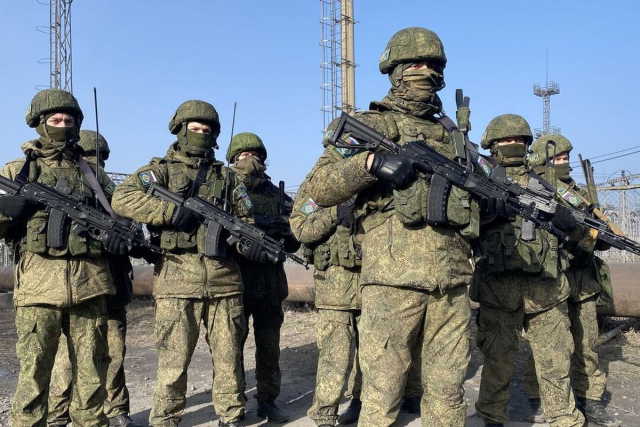
Airborne troops of Russia: genesis
The Airborne Troops of Russia (Airborne) have a long tradition dating back to the 1930s. Airborne forces have been noted in all armed conflicts involving the Soviet Union and Russia since 1941.
The creation of Soviet Airborne troops in the post-war period is largely due to the efforts of one man, Army General Vasily MARGELOV, so the abbreviation of Airborne troops for Airborne Troops is sometimes jokingly interpreted as "Uncle Vasya's Troops".
Airborne units of two divisions (the 7th and 31st Guards) were used in Soviet operations in 1956 in Hungary. The 7th Guards Division also took part in the invasion of Czechoslovakia in 1968.
The first experimental airborne brigade, the 1st Airborne Brigade, apparently was formed from parts of the 51st Guards Parachute Regiment (PDP, Tula) in 1967/1968 after the Soviets studied the American experience in Vietnam. In 1973, the 13th and 99th Airborne Divisions were reorganized into airborne brigades, as a result of which the number of divisions was reduced to eight. There were also separate regiments and battalions. But even in the 1980s, with the help of all military transport aircraft of the Air Force and Aeroflot, only two airborne divisions could be used to carry out combat missions of the first wave against NATO.
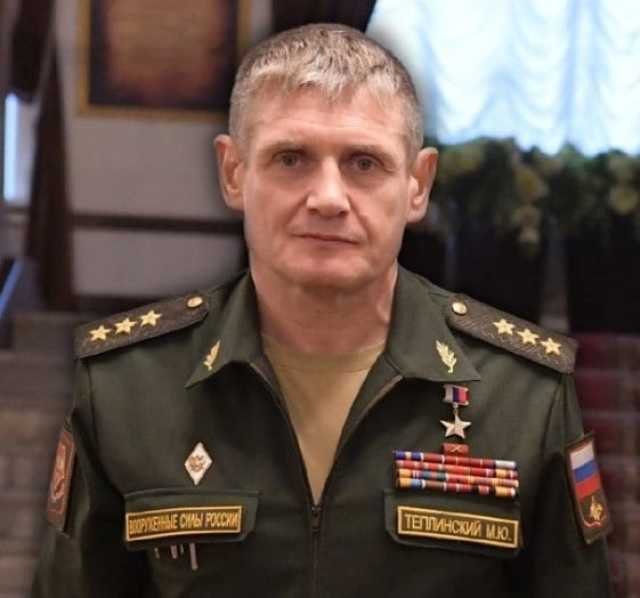
Commander of the Airborne Forces Colonel-General M. Teplinsky
As part of the Russian Armed Forces, the Airborne Forces form a separate branch of the armed Forces, which reports directly to the Supreme Command of the Russian Armed Forces. Currently, the Airborne Forces are headed by Colonel-General Andrey Serdyukov [since June 16, 2022, Hero of Russia Colonel-General Mikhail Teplinsky has been appointed Commander of the Airborne Forces of Russia].
The Airborne Forces include both airborne and amphibious assault formations, which makes this service part of an extremely flexible tool of the Russian armed forces. They form the core of the Russian crisis response forces. The number of troops is more than 72 thousand soldiers. This means that the Russian Airborne Forces are an armed force roughly comparable to all German ground forces. Although the staff of the SV Bundeswehr has about 65 thousand personnel, they have a much larger shortage of military personnel.
Organization
As of 2022 [January] The airborne troops of Russia are organized as follows:
- 7th Guards Airborne Division (mountain) in Novorossiysk,
- 76th Guards Airborne Assault Division in Pskov,
- 98th Guards Airborne Division in Ivanovo (transferred to Kazakhstan in 2022),
- 106th Guards Airborne Division in Tula,
- 11th Guards Airborne Brigade in Ulan-Ude,
- 31st Guards Airborne Brigade in Ulyanovsk (transferred to Kazakhstan in 2022),
- 56th Guards Airborne Brigade in Kamyshin (currently the brigade is being reorganized into a regiment and relocated to Feodosia in the Crimea),
- 83rd Guards Airborne Brigade in Ussuriysk,
- 242nd Airborne Training Center in Omsk,
- 38th Guards Airborne Communications Brigade in Bear Lakes,
- 45th Guards Separate Special Purpose Brigade in Kubinka (transferred to Kazakhstan in 2022).
As part of the airborne assault divisions in 2021, two airborne assault regiments were formed in Pskov and in the Crimea.
Equipment and weapons
Personal firearms and squad weapons include:
- 5.45×39 mm AK-74M automatic rifles, including variants upgraded with the KM-AK kit "Body Kit", AKS-74 automatic rifles, as well as AKS-74U automatic rifles,
- 5.45×39 mm AK-12 automatic rifles,
- 5.45×39 mm RPK-74 hand machine gun (currently discontinued and replaced with PKM/Control panel),
- universal machine gun caliber 7.62×54 mm PCM,
- The 7.62×54 mm 6P41 Pecheneg universal machine gun (PKP), currently replacing the PKM as a universal machine gun in the Russian Armed Forces,
- Dragunov sniper rifle SVDS 7.62×54 mm,
- the modified SVD IED in the bullpup configuration and its variants have limited use,
- the main sniper rifle caliber 7.62×54mm SV-98,
- large-caliber sniper rifle 12.7×108 mm ASVK-M "Cord-M",
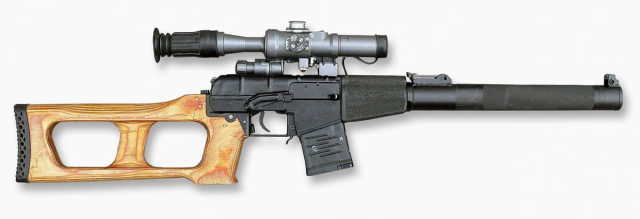
VSS "Vintorez" sniper rifle
- sniper rifle with silencer 9×39 mm VSS "Vintorez",
- special assault rifle AS "Val",
- semi-automatic pistol chambered in 9×19 mm Parabellum MR-443 "Grach",
- Makarov 9x18 mm PM semi–automatic pistol, Glock 17 - 9x19 mm Parabellum semi-automatic pistol,
- under-barrel 40 mm grenade launchers for fragmentation and chemical grenades GP-25, GP-30 and GP-34,
- 30 mm automatic grenade launcher AGS-17 "Flame",
- the rocket-propelled infantry flamethrower RPO-A "Bumblebee", currently replaces the older RPO "Lynx",
- RPG-7D hand-held anti-tank grenade launcher: or more modern systems such as RPG-22 and RPG-26,
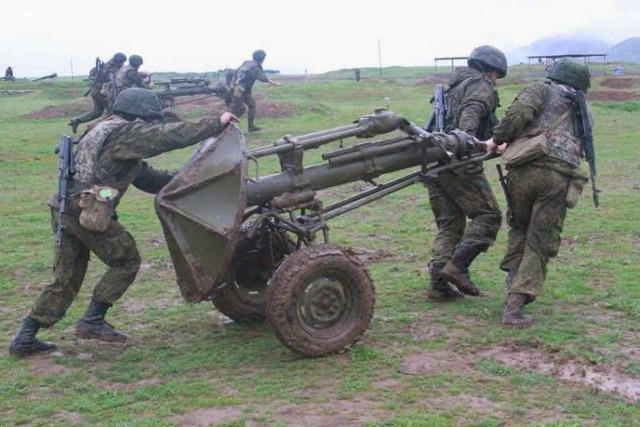
120 mm mortar 2S12 "Sleigh"
- 82 mm mortar 2B14 "Tray" or 120 mm mortar 2C12 "Sleigh" on UAZ cars,
- portable SAM 9K38 "Igla" or more modern 9K338 "Igla-S",
- portable air defense system 9K333 "Willow", currently entering service,
- portable anti-tank complexes 9K111 "Fagot", 9K115 "Metis" and 9M133 "Cornet".
As of 2018, the Airborne troops of Russia are fully equipped with sets of field uniforms and equipment "Barmika" and "Ratnik". In addition, they are armed with: automated control systems "Andromeda-D", "Barnaul-T" and "Dozor", snowmobiles AS-1, ATVs, specially designed for hot climates form and Arctic equipment "Nanuk", intelligence management and planning modules, as well as developed by a subsidiary of the concern "Kalashnikov" by ZALA Aero Group resembles a rifle portable interference generator Rex-1, used to combat UAVs.
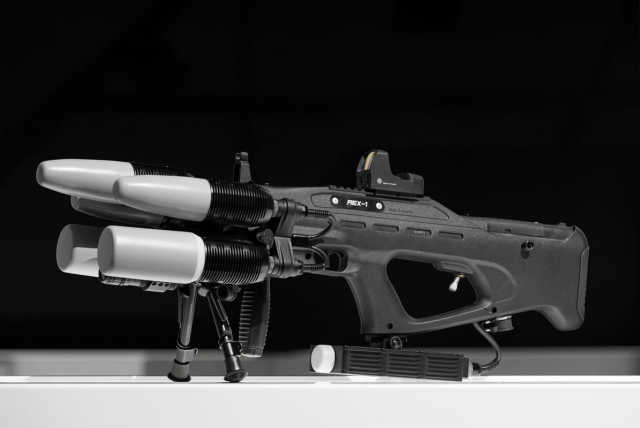
Portable interference generator anitidron Rex-1
Airborne troops will receive portable versions of the Harmony anti-aircraft radar, upgraded reconnaissance and artillery fire control stations of the Aistenok and Sobolyatnik radars. The Russian Airborne Forces also received new special parachutes of the guided wing type.
In 2020, the Airborne Forces continued to modernize and re-equip command posts. The purchase of the high-altitude parachute system "Steyer", which allows landing from a height of up to 10,000 m, has been completed, the purchase of controlled special parachute systems has been completed. The Russian Defense Ministry also adopted the airborne artillery fire control vehicle "Covenant-D".
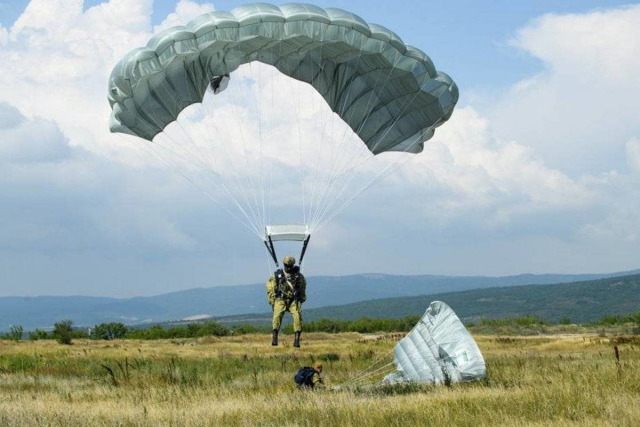
High-altitude parachute system "Steyer"
Unlike other mechanized units that use various armored vehicles of the BMP, BTR and MT-LB series, the Airborne Forces uses exclusively vehicles of the amphibious assault vehicle (BMD) family. There are more than 1,800 armored combat vehicles, mainly BMD-1 (produced since 1969), of which, in addition to about 100, are in reserve, and at least several hundred BMD-2 (since 1985). There are also more than 100 BMD-3 (1990), some of which have been upgraded up to the BMD4 level. All of them are amphibious and move through the water at a speed of about 10 km/h.
The BMD-4 is also capable of conducting full-fledged continuous fire while afloat, which no other vehicle with such heavy weapons (100-mm cannon and 30-mm automatic cannon) has. However, it is known that some units (for example, deployed for peacekeeping operations in the Balkans) used armored personnel carriers, not BMD.
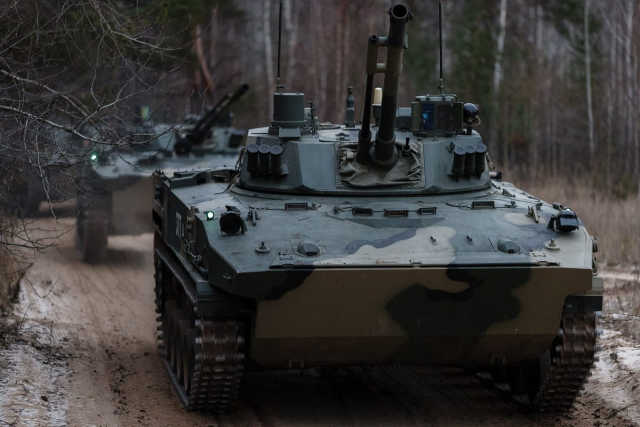
BMD-4M amphibious Assault vehicle
The T-72B3 tanks that entered the Russian Airborne Forces in 2018 were upgraded and equipped with the Andromeda automatic control system. Since 2021, the Russian Airborne Forces have 150 T-72B3 and 10 T-72B3 samples of 2016. There is also a reckless version of the BMD-1, BTR-D, which is used as a transport vehicle and serves as the basis for specialized versions, such as anti-tank, command and staff vehicles and communications vehicles. The BTR-D is partially planned to be replaced by a new multipurpose armored vehicle BTR-MD "Shell", which will also be presented in several modifications. There are about 280 BTR-D vehicles in service in all configurations. The first serial batch of new BMD-4M and BTR-MDM "Pantsir" in the amount of 24 units (twelve of each model) was transferred to the Airborne Troops of Russia in 2015. In 2016, the Airborne Forces equipped the BMD4M and BTR-MDM first regiment. In 2017, they received two battalion sets of amphibious vehicles BMD-4M and BTR-MDM, as well as more than 80 armored vehicles "Lynx" and UAZ "Pickup".
The airborne brigades of Russia received armored vehicles GAZ-233036 "Tiger" SPM-2. Kamaz Typhoon armored personnel carriers were also ordered, which, after modifications for the needs of the Airborne Forces, arrived in August 2021. The airborne troops of Russia received about 100 special armored vehicles "Tiger" and "Lynx", 200 snowmobiles-all-terrain vehicles "Snowmobile A-1" and "AM-1", light cars UAZ "Patriot", armored vehicles "Toros" 4x4 and amphibious trucks "Kamaz". Currently, the Airborne Forces are receiving armored snowmobiles "Berkut" for the transportation of personnel and fire support in Arctic conditions. Infauna and Leer-2 electronic warfare systems will also be delivered, as well as Aileron-3SV drones and P-230T command vehicles. In August 2021, the RHM-6 chemical reconnaissance vehicle based on the BTR-80, the BTR-D with the ZU-23 anti-aircraft gun and the R-149MA1 and R-142DA command and staff vehicles were demonstrated. A light tactical vehicle of the Sarmat-2 buggy type took part in the Zapad-2021 exercise.
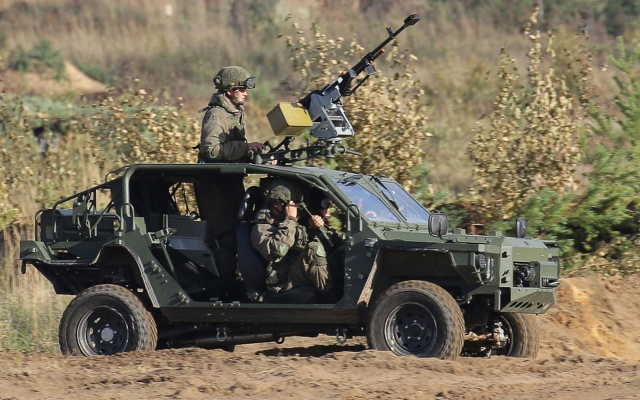
Light tactical vehicle "Sarmat-2"
As it was reported on August 1, 2013, the Russian Airborne Forces will develop a hybrid combat vehicle that combines the features of an amphibious assault vehicle and a helicopter. To meet the needs of future armed conflicts, a combat module is being considered, combining a light combat vehicle and an attack helicopter with a crew of three or four people. The device should be developed for the airborne Forces by 2030.
The airmobile artillery installations ASU-57 and ASU-85 were written off. They had light armor and had limited anti—tank capabilities, but provided invaluable fire support to paratroopers behind enemy lines (the caliber of the gun in millimeters is the number next to the designation of the ACS).
140-mm MLRS RPU-14 (8U38) and 122-mm MLRS BM-21V "Grad-V" (9P125) were also written off for GAZ-66 and 85-mm SD-44 cannon. To date, the following systems are operated in the Airborne Forces:
- 2S9 "Nona" and the upgraded 120-mm ACS 2S9M, currently replaced by 120-mm towed mortar 2B23 "Nona-M1" and 120-mm ACS 2S31 "Vienna"/2S12A (upgraded),
- 125 mm self-propelled/anti-tank gun 2S25 "Sprut-SD" based on the BMD-3 body,
- 122 mm self-propelled howitzer and anti-tank gun D-30 (2A18), towed by a truck, not floating, can rotate 360 degrees because it is mounted on a tripod,
- The ZU-23-2 23-mm anti-aircraft gun is either mounted on an APC-D, or can be towed by a jeep or truck, since it has wheels. Since 2011, some ZU-23s have been replaced with the Strela-10M3/MN, and since 2016 — with the latest versions of the Buk air defense system.
- 2S36 "Zauralets-D" - future 120-mm self-propelled gun based on BMD-4,
- "2S37" is a future 152-mm self-propelled gun based on the BMD-4.
The Airborne Forces have a lot of trucks and jeeps suitable for airborne landing, for example, Ural-4320, GAZ-66V and GAZ-2975 "Tiger" for transporting cargo, special personnel and equipment (for example, mortars, ammunition), but not the personnel of the main units (all paratroopers are transported in armored personnel carriers). Currently, the KamAZ-43501 is replacing the GAZ-66.
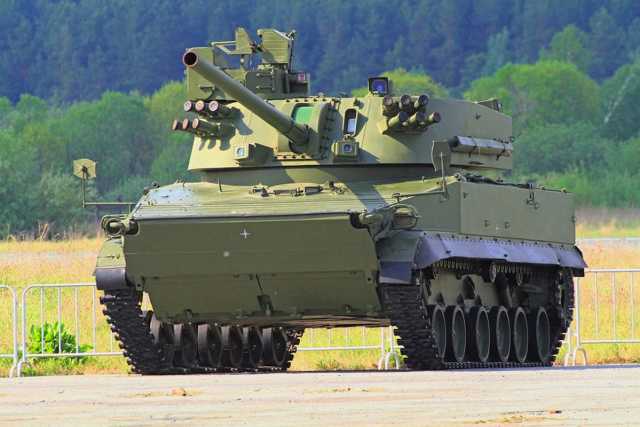
ACS 2C31 "Vienna"
In addition, there are the following types of UAVs: a small-sized reconnaissance complex "Seeker" with two UAVs, a complex of UAVs "Orlan-10", a UAV complex "Garnet", as well as a UAV complex "Tachyon".
Conclusion
According to the Russian military leadership, the quantitatively significant Airborne Troops of Russia will continue to play a decisive role. Accordingly, the modernization of these forces will remain a priority. Almost all equipment is classified by the Russian Defense Ministry as "modern". Although this term is not defined, it obviously means the presence of almost completely post-Soviet equipment in the troops. This is by no means the norm in the rest of the Russian army.
The current mission in Kazakhstan shows the high flexibility of the airborne forces, which can also become a dangerous enemy for NATO, for example, in the case of an intervention operation in the Baltic region. Due to their relatively heavy equipment, the airborne forces are able to conduct at least one long-term deterrent battle with a mechanized enemy. In addition, the airborne forces interact with specialized forces and special forces in the event of their operations, which again increases the risk potential for the defending NATO forces.
Based on the materials of the journal Europäische Sicherheit & Technik
The materials of the article contain exclusively the author's estimates and do not reflect the position of the editorial board of IVi.
